Thank you for visiting! By the way… any links on this page that lead to products on Amazon and other stores/partners are affiliate links Aquarium Store Depot earns a commission if you make a purchase.
Did you know that not all aquarium fish need warm water? The range might be a little more limited, but there are many fascinating species that you can keep in an unheated tank!
In this article, I’ll be introducing 20 great coldwater fish that you can keep in your aquarium. I’ll also share some tips on how to keep their water cool and other important information about their care.
So let’s get started!
What Is A Coldwater Aquarium Fish?
Cold water aquarium fish can survive in temperatures of 70°F or lower. They are species that come from the subtropical and temperate parts of the world where the water isn’t always warm.
Unlike most tropical fish, cold-water fish do not need a heater to survive in the home aquarium. These fish are at home in the same temperatures that most people are, so the natural room temperature of your home is usually fine for them.
The Advantages
Keeping coldwater fish can have some real benefits for aquarists and the fish themselves. Let’s take a look at some of the reasons you might choose to keep cold-water fish over tropical species.
You Don’t Need A Heater
Not needing a heater to keep the water temperature in the comfortable range has a few benefits that you might not realize.
Firstly, you don’t need to buy an aquarium heater or pay for the energy they use. In this hobby, every cent counts right? You can also think of this as a more eco-friendly option.
Heaters can be unsightly too, so you’re also able to create a more natural-looking aquarium, and reduce the amount of hardware and electrical cords you need to hide.
It Can Be Safer
Power interruptions are a fact of life for many people. With an unheated tank, you don’t need to panic when the power goes out.
Even when the lights stay on, aquarium heaters can still malfunction. This is another thing you don’t have to worry about with an unheated tank.
Less Cleaning
Algae thrive in warm water, and this can be a real challenge in planted tropical fish tanks. Coldwater can be a real blessing in heavily planted aquariums and aquascapes because the plants and glass are less likely to be covered.
15 Best Tanks
Now that you know what a cold-water fish is, it’s time to get to know some of the best species for your aquarium. I’ll be listing some important stats for each species, so you can make sure you’re making the right choice. These are:
- The fish’s scientific name
- Its size when fully grown
- How easy it is to care for
- The minimum suitable tank size
- The fish’s temperament
- What the fish eats
- Where it comes from
- The water temperature the fish prefers
- It’s swimming level in the aquarium
So let’s meet them now! You can see our YouTube Video below from our channel and also follow along in our blog post:
Let’s meet our fish!
1. Japanese Rice
Japanese rice fish are a commonly overlooked fish suitable for freshwater aquascapes. Very peaceful and hardy fish that color up with companions
- Scientific Name: Oryzias latipes
- Adult Size: 1.5 inches
- Care Level: Easy
- Minimum Tank Size: 10 gallons
- Temperament: Peaceful
- Diet: Carnivore, feed dried, live & frozen foods
- Origin: Eastern Asia
- Water Temperature: 64-71°F
- Swimming Level: All levels
The Japanese rice fish or Medaka fish is a great coldwater species for nano tanks. They get their name because they are often found living wild in rice paddies.
The wild type is not the most colorful fish out there, but they are amazing to watch. A golden variety, as well as some genetically modified glowing varieties, have also been developed if you’re looking for more color. These tiny schooling fish will be happiest if kept in groups of 8 or more.
2. Bloodfin Tetra
Use Promo Code ASDFLIPPROMO
A great-looking nano fish with a reddish fin. Grows to 2 inches in length and fairly peaceful in nature
- Scientific Name: Aphyocharax anisitsi
- Adult Size: 2 inches
- Care Level: Easy
- Minimum Tank Size: 15 gallons
- Temperament: Semi-aggressive, nips fins
- Diet: Carnivore, feed dried, live & frozen foods
- Origin: Brazil, Argentina, Paraguay
- Water Temperature: 64-82°F
- Swimming Level: Midwater
The bloodfin tetra is a great schooling fish for unheated aquariums. Their blood-red fins give these silvery fish a striking look in the aquarium.
They are very hardy fish that are adaptable to a wide range of water temperatures, which means you don’t have to worry if it gets a little warmer than usual. These long-lived tetras regularly survive for over 5 years, especially if kept in groups of 6 or more.
3. White Cloud Mountain Minnow
A very peaceful fish that does well in coldwater fish. Other minnow varieties are also available
- Scientific Name: Tanichthys albonubes
- Adult Size: 1.5 inches
- Care Level: Easy
- Minimum Tank Size: 10 gallons
- Temperament: Peaceful
- Diet: Carnivore, feed dried, live, and frozen foods
- Origin: China
- Water Temperature: 58-72°F
- Swimming Level: Midwater
White cloud mountain minnows are one of the best cold-water fish in the aquarium hobby. These schooling fish get their name from the White cloud mountain in China1, where they can be found living wild.
These peaceful fish are available in some awesome varieties including gold and long-finned types. They prefer cooler water temperatures and are easy to care for. The white cloud mountain minnow is a great choice for a community tank if kept with other peaceful fish.
4. Panda Corydoras
A small cory fish that does well in shrimp tanks. Grows to 2.5 inches in length
- Scientific Name: Corydoras panda
- Adult Size: 2 inches
- Care Level: Easy-moderate
- Minimum Tank Size: 10 gallons
- Temperament: Peaceful
- Diet: Omnivore, feed sinking dried foods, live and frozen supplements
- Origin: Peru
- Water Temperature: 68-77°F
- Swimming Level: Bottom
Panda corydoras get their name from their bold black and white markings and black eyestripe. These adorable catfish are great for cold water aquariums, even though commercially bred individuals are less fussy about water temperatures than wild-caught fish.
Panda cory catfish are very peaceful and social bottom feeders that will be most confident in a school of 6 or more.
5. Guppies
An undemanding fish that is a livebearer. Many varieties available
- Scientific Name: Poecilia reticulata
- Adult Size: 1-2.5 inches
- Care Level: Easy
- Minimum Tank Size: 10 gallons
- Temperament: Peaceful
- Diet: Omnivores, feed dried, live, and frozen foods
- Origin: South America and the Caribbean
- Water Temperature: 63-82°F
- Swimming Level: All levels
Guppies are one of the most popular pet fish on the planet. They are very adaptable and do just as well as cold-water fish as they do in a community tank with tropical fish. These peaceful fish have been bred to display an amazing variety of colors.
Guppies are livebearers, which means they give birth to live fry instead of laying eggs. It is best to keep only one sex if you don’t want these fish to multiply in your aquarium.
6. Endler’s Livebearer
A very active and colorful livebearer. Smaller in size than guppies
- Scientific Name: Poecilia wingei
- Adult Size: 1-1.8 inches
- Care Level: Easy
- Minimum Tank Size: 10 gallons
- Temperament: Peaceful
- Diet: Omnivores, feed dried, live, and frozen foods
- Origin: Venezuela, South America
- Water Temperature: 64-84°F
- Swimming Level: All levels
Endler’s livebearers are another awesome nano species for coldwater aquariums. These tiny fish look very similar to guppies, but they stay much smaller at under 2 inches in length. They are not cold-water fish specifically, but they are very hardy and will do great in an unheated tank in a warm home.
7. Bristle Nose Pleco
The Bristlenose Pleco is a smaller Pleco that does a great job of eating algae. Peaceful and gets along with most fish
- Scientific Name: Ancistrus sp.
- Adult Size: 4-5 inches
- Care Level: Moderate
- Minimum Tank Size: 15 gallons
- Temperament: Peaceful
- Diet: Herbivore, feed algae wafers & vegetables
- Origin: Argentina
- Water Temperature: 70-79°F
- Swimming Level: Bottom
The bristle nose pleco is an unusual fish that is very useful for eating algae. Most people assume these fish can only be kept in tropical aquariums, but they are comfortable in most unheated aquariums and many aquarists have even managed to keep them with goldfish.
Bristlenose plecos are vegetarian fish that need plenty of driftwood to graze on. They are such efficient algae eaters that you’ll need to supplement their diet with spirulina wafers and veggies to keep them well fed. The pleco pictured above is the Albino breed.
8. Dojo Loach
A bottom-dwelling fish that is very adaptable. Compatible in both tropical and coldwater environments
- Scientific Name: Misgurnus anguillicaudatus
- Adult Size: 6-12 inches
- Care Level: Easy
- Minimum Tank Size: 55 gallons
- Temperament: Peaceful
- Diet: Carnivore, feed sinking dried foods
- Origin: Central & Eastern Asia
- Water Temperature: 59-77°F
- Swimming Level: Bottom
The dojo loach is a great coldwater fish species for larger aquariums. Some aquarists even keep these interesting loach fish in outdoor ponds with Koi.
The dojo loach is also known as the weather loach because they become more active when the barometric pressure changes. These interesting fish can reach up to 12 inches in length, which means they should be kept in a freshwater aquarium that holds at least 55 gallons.
9. Rosy Barb
- Scientific Name: Pethia conchonius
- Adult Size: 3 inches
- Care Level: Easy
- Minimum Tank Size: 25 gallons
- Temperament: Peaceful
- Diet: Omnivore, feed dried, live, and frozen foods
- Origin: India, Nepal, Bangladesh, Pakistan
- Water Temperature: 60-75°F
- Swimming Level: Midwater
Rosy barbs are another great species for unheated tanks. These beautiful fish have large, highly reflective scales and come in some amazing varieties like the long-fins and neons (video source).
They are social cyprinids that like to swim in larger schools, so pick up a group of 10 or more if possible. These schooling fish are easy to care for, but not the best choice for planted tanks because they tend to nibble on leaves.
10. Gold Barb
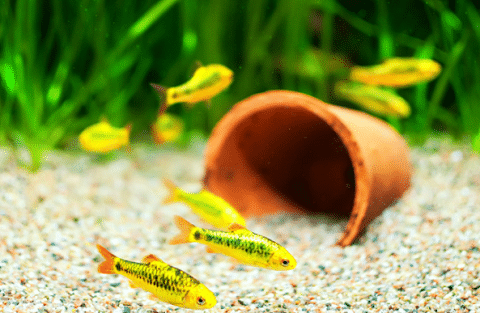
- Scientific Name: Barbodes semifasciolatus
- Adult Size: 2.5-3 inches
- Care Level: Peaceful
- Minimum Tank Size: 20 gallons
- Temperament: Semi-aggressive
- Diet: Omnivore, feed dried, frozen, and live foods
- Origin: China, Vietnam, Taiwan
- Water Temperature: 61-75°F
- Swimming Level: Bottom, midwater
Gold barbs are a great choice for cold water tanks with lower water temperatures. These social fish are also known as the Chinese barb fish and they should be kept in a school of at least 8.
Although wild gold barbs are greenish, the fish in the aquarium trade have been bred to have an amazing golden body color with dark blotches and reddish eyes and fins. A cool albino form is also available from time to time.
11. Axolotl
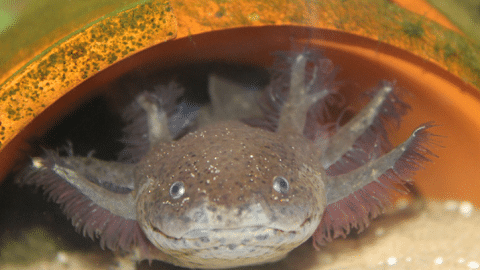
- Scientific Name: Ambystoma mexicanum
- Adult Size: 6-12 inches
- Care Level: Moderate
- Minimum Tank Size: 15 gallons
- Temperament: Semi-aggressive
- Diet: Carnivore, feed pellets, frozen or live food
- Origin: Mexico
- Water Temperature: 57-68°F
- Swimming Level: Bottom
The axolotl is also known as the Mexican walking fish, but did you know that these amazing animals are not really fish at all? Axolotls are actually amphibians, just like frogs and salamanders! These creatures make amazing and unusual pets for freshwater aquariums.
Axolotls spend their whole lives underwater and do best when kept on their own. This is because they have a tendency to eat nano fish or even each other! They need cool water and are more active in low lighting because they are nocturnal.
12. Fancy Goldfish
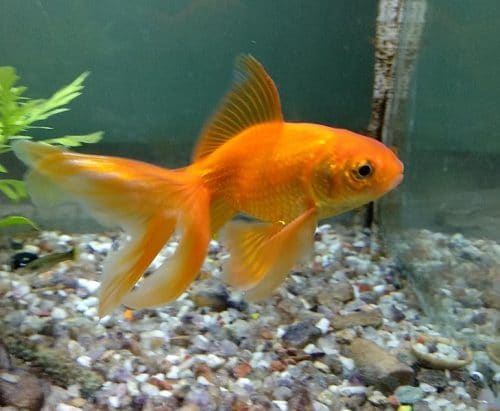
- Scientific Name: Carassius auratus
- Adult Size: 6-8 inches
- Care Level: Moderate
- Minimum Tank Size: 20 gallons
- Temperament: Peaceful
- Diet: Omnivore, feed dried, live, and frozen foods
- Origin: China and Eastern Asia
- Water Temperature: 65-72°F
- Swimming Level: Midwater
Goldfish are more than just feeder fish. The fancy goldfish is one of the best cold-water fish and one of the most popular pets in the world!
These fish are available in a huge range of different breeds, including amazing fish like orandas, ranchus, and bubble-eyes. Fancy goldfish can reach over 8 inches in length, and they need a larger tank than you might think, so don’t be tempted to set them up in a goldfish bowl from your local fish store.
13. Sunset Variatus

- Scientific Name: Xiphophorus variatus
- Adult Size: 2-2.8 inches
- Care Level: Easy
- Minimum Tank Size: 15 gallons
- Temperament: Peaceful
- Diet: Omnivore, feed dried, live, and frozen foods
- Origin: Mexico
- Water Temperature: 68-79°F
- Swimming Level: All levels
The sunset variatus is another great little livebearer for a cold water tank. This morph of the variable platy has amazing red and yellow colors, just like the sky at sunset. Sunset variatus prefer higher pH water conditions, just like many other livebearers.
14. Celestial Pearl Danio
A great-looking danio fish. Males are more colorful than females. A midway dwelling fish
- Scientific Name: Celestichthys margaritatus
- Adult Size: 0.75 inches
- Care Level: Moderate
- Minimum Tank Size: 10 gallons
- Temperament: Peaceful
- Diet: Omnivore, feed dried, live, and frozen foods
- Origin: Myanmar, Thailand
- Water Temperature: 68-78°F
- Swimming Level: Midwater
The celestial pearl danio is an awesome nano fish species that looks amazing in a heavily planted tank. These fish are also known as galaxy rasboras or just CPDs for short.
They are fairly timid fish that prefer cooler water temperatures. Celestial pearl danios can be kept with other fish, provided their tank mates are peaceful and stay small.
15. Zebra Danio
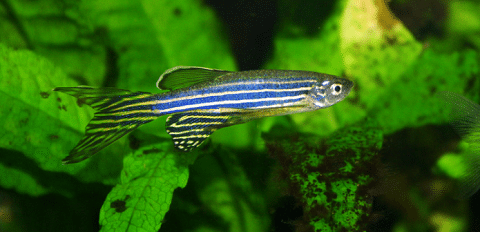
- Scientific Name: Brachydanio rerio
- Adult Size: 1.5-2 inches
- Care Level: Easy
- Minimum Tank Size: 10 gallons
- Temperament: Peaceful
- Diet: Carnivore, feed dried, live, and frozen foods
- Origin: India
- Water Temperature: 70-82°F
- Swimming Level: Top, Midwater
The zebra danio is another great cold-water fish that is really underrated in the aquarium hobby. Zebra danios are peaceful and hardy fish that are easy to care for. Zebra danios are fast swimming, active danio fish that are amazing in community tanks and get along with many fish.
16. Paradise

- Scientific Name: Macropodus opercularis
- Adult Size: 3 inches
- Care Level: Easy
- Minimum Tank Size: 20 gallons
- Temperament: Semi-aggressive
- Diet: Carnivore, feed dried, live, and frozen foods
- Origin: South and East Asia
- Water Temperature: 50-71°F
- Swimming Level: Top, Midwater
The paradise fish is also known as the paradise gourami or the Chinese fighting fish. These beautiful fish are related to betta fish and have all the colors of a tropical species, but are happy in an unheated tank.
Paradise fish have a reputation for being aggressive fish and do best in a species-only tank. Keep a single male and 2 or more females if you plan on keeping a group of these feisty fish.
17. Mosquito
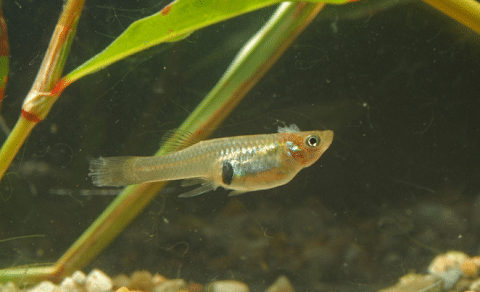
- Scientific Name: Gambusia affinis
- Adult Size: 1.5-2.5 inches
- Care Level: Easy
- Minimum Tank Size: 5 gallons
- Temperament: Semi-aggressive
- Diet: Omnivore, feed dried, live, and frozen foods
- Origin: USA and Mexico
- Water Temperature: 50-84°F
- Swimming Level: All levels
The mosquito fish is a small fish species that is usually kept outdoors in ponds as a mosquito larvae control. They can actually make a really fascinating cold water pet fish, however.
One thing to note is that mosquito fish can be pretty aggressive and are known to nip the fins of their tank mates. They are very hardy fish and make an interesting choice for an unheated nano tank.
18. Asian Stone Catfish
- Scientific Name: Hara jerdoni
- Adult Size: 1.2 inches
- Care Level: Moderate
- Minimum Tank Size: 10 gallons
- Temperament: Peaceful
- Diet: Carnivore, feed live and frozen foods
- Origin: Bangladesh, India
- Water Temperature: 64-75°F
- Swimming Level: Bottom
The Asian stone catfish (video source) is a unique little nocturnal fish for unheated aquariums. They are not super active fish and make a great choice for a nano tank.
The Asian stone catfish can also be kept in a community tank as long as its tank mates are also small and peaceful. Feeding them at night is recommended because they are clumsy and the other fish can easily out-compete them for slow sinking food like frozen brine shrimp.
19. Rosy Red Minnows
- Scientific Name: Pimephales promelas
- Adult Size: 3 inches
- Care Level: Easy
- Minimum Tank Size: 15 gallons
- Temperament: Peaceful
- Diet: Omnivore, feed dried, live, and frozen foods
- Origin: Canada, USA, Mexico
- Water Temperature: 50-78°F
- Swimming Level: Midwater
Rosy red minnows are more often used as bait and feeder fish than kept as pets. That’s a shame because they are great-looking fish that are perfect for cold water tanks! Rosy red minnows can be kept in a huge range of water temperatures and are even good for ponds outdoors.
20. Pygmy Sunfish

- Scientific Name: Elassoma evergladei
- Adult Size: 1.4 inches
- Care Level: Moderate
- Minimum Tank Size: 10 gallons
- Temperament: Peaceful, shy
- Diet: Carnivore, feed live and frozen food
- Origin: USA
- Water Temperature: 50-72°F
- Swimming Level: Bottom, midwater
The pygmy sunfish (picture source) is a cute little fish that is native to the Southeastern United States. The breeding males have stunning iridescent blue and black colors.
Pygmy sunfish are not usually seen in fish stores, although they do great in unheated aquariums. These tiny fish are actually more popular with fish keepers over in Europe than in their native North America.
Coldwater Tank Setup
Setting up a coldwater tank is just the same as setting up a tropical tank, only you won’t be using a heater. If you live in a tropical climate, however, you might need to take some steps to manage the water temperatures.
Managing Your Tank In Warm Climates
When summer comes along and temperatures in the house begin to rise, keeping your cool water fish comfortable can be tough! Here’s a list of 6 great tips on keeping your fish cool:
1. Monitor the temperature
The most important tool for managing the temperature in your cold water aquarium is a thermometer. A cost-effective solution is to use a simple glass thermometer and keep an eye on it whenever it feels a little warm in your home.
An even better option is to use a digital thermometer with a programmable alarm. This way, you can set the device to alert you when the water temperature rises beyond a certain point. Pretty smart!
2. Use minimal equipment
Knowing the actual temperature in your tank is one thing, but what can you do to keep the temperature in the safe range for your fish?
The first thing to do is switch off or remove any unnecessary equipment in the tank. Things like lights and powerheads give off small amounts of heat and can be switched off temporarily without any harm.
It’s not only the hardware inside your tank that can warm up the water, however. Computers, televisions, refrigerators, and all sorts of appliances can warm up the air around your aquarium.
3. Choose the right lighting
You might not realize it, but some aquarium lights produce plenty of heat. Not all types of aquarium lighting produce the same amount of heat, however.
Switch to LED lighting if your lights are creating heat. This is the best option for keeping your coldwater fish comfortable.
4. Turn on the AC
The temperature of the water in your aquarium is directly affected by the temperature of the air in the room. You can keep your aquarium water temperature down by keeping the room cool with air conditioning. This might not be the most energy-efficient method, but it is very effective! Another alternative is using a mobile AC system.
Mobile AC units are an unconventional, but very effective and cheaper solution over many chiller options
5. Choose the right location
Not all areas of your home have the same temperature. The north side of your house will usually be cooler than the south if you live in America, Europe, or anywhere north of the equator.
Heat always rises, so the coolest part of your home will usually be downstairs or in the basement. Direct sunlight can heat the water in your tank, even if the air temperature is cool. Never set up an aquarium where it will receive direct sunlight.
6. Cool the water
You will need to cool down the water in your tank if you’ve followed all the tips above, and the water temperature is still rising too much.
The best way to do this is to use an aquarium chiller. These devices are not cheap, but they are very effective because they refrigerate the water. Aquarium chillers can be programmed to maintain a stable, constant temperature of your choice.
A less reliable, but much cheaper option is to run an airstone and an aquarium fan on the water surface. This works best in a tank with no hood. A mesh screen might be necessary though because many fish species can jump out of their tank.
Whichever method you use, make sure you change the temperature gradually to avoid stressing your fish.
Filtration
All aquariums should have good quality filtration to keep the water quality safe, and the tank looking beautiful. Coldwater tanks are no exception, and you can use the same varieties of aquarium filters as you would in a tropical setup.
An air-powered sponge filter is a great option because they do not create any heat and actually help to cool the water slightly. An external canister filter will provide superior filtration, however, and has the added benefit of not cluttering up the tank.
Tank Maintenance
Regular tank maintenance is really important for keeping your coldwater fish healthy and happy. A nice clean tank also looks great, so you can enjoy watching your fish even more. Here’s what you’ll need to do:
Testing
Being able to test your water parameters is really important for maintaining your fish tank. Firstly, testing will show you the pH and hardness of your water, which is very important for most species.
Testing for ammonia and nitrite will also allow you to determine whether your aquarium is cycled or not, and whether it’s safe to start introducing fish to a new tank.
Lastly, regular testing for nitrate levels is necessary to work out the perfect maintenance schedule for your tank.
Aquarium test kits are super easy to use, just make sure you buy a kit that can measure the following parameters:
- pH
- GH
- KH
- Ammonia
- Nitrite
- Nitrate
Water Changes
In a healthy, cycled aquarium, beneficial bacteria break down harmful chemicals known as ammonia and nitrite into nitrate. Nitrate is a lot less toxic, but in large concentrations, this compound can still be dangerous.
Growing plenty of live plants can help to lower the level of nitrates in your tank, but the best way is to physically remove them by replacing some of the water. Use your test kit to measure the nitrate in your water. Ideally, you should try to keep the nitrate levels below 20 parts per million.
The process of performing a partial water change is simple. Start by preparing some fresh water. Use a water conditioner to neutralize any chemicals and allow the water to reach the same temperature as your tank water. You will need the same amount of water as you plan on removing.
Next, suck out water from the bottom of the tank with your gravel vacuum and into a bucket or drain. This will remove all the waste particles that have settled on the substrate.
All you have to do now is add the new water to the tank. Pour it in slowly to avoid stirring up the substrate and uprooting any plants.
Other Maintenance Tasks
You’ll also want to clean the algae off your aquarium glass from time to time. You can do this whenever necessary, but I suggest doing this just before your water change. That way you can suck up any loose algae!
You’ll also need to rinse out your aquarium filter media from time to time. There are colonies of beneficial bacteria that live in the filter media of a cycled freshwater aquarium. They are sensitive to tap water, so remember to clean your filter media in the water you have removed from the tank.
Setting Up A Coldwater Community Tank
You can set up an awesome unheated community tank, even though the options are a little more limited. Read on for some handy tips to help you stock your cold water tank.
Choosing Tank Mates
Choosing the right tank mates is essential to ensure that all your pets get along in the aquarium. The most important factors when selecting tank mates are:
- Temperature compatibility
- Other parameters like pH and hardness
- Size and aggression levels
Live Plants
Coldwater aquariums are not only for fish. You can also grow a variety of awesome live plants in an unheated tank. The following beginner live plant species are all great options:
You’ll need to read up on the needs of each plant species to learn how to care for them because their needs do vary.
What About Freshwater Tank Shrimp And Snails?
The good news is that you can keep freshwater invertebrates in a coldwater tank too! Not all inverts like cool water, however.
The following species are safe bets:
- Cherry shrimp (Neocardinia) – Minimum temperature 65°F
- Caridina shrimp – Minimum temperature 64°F
- Amano shrimp – Minimum temperature 64°F
- Malaysian trumpet snails – Minimum temperature 65°F
- Japanese trapdoor snail – Minimum temperature 68°F
Shrimp and snails are great because they help to keep your aquarium clean. Shrimp don’t always make the best tank mates for community tanks, however. Some cold-water species like paradise fish will probably see your shrimp as a tasty snack!
Where To Buy
You can usually find the more popular coldwater species at your local fish stores. Another great place to shop aquarium fish is online, especially if you’re looking for specific fish species.
FAQs
Can a cold water tank be too cold?
All fish species have an ideal temperature range where they are most comfortable. If the water in your tank gets too cold, your fish will be under stress and might not survive.
Do you need a heater for cold water tanks?
Coldwater fish only need a heater in very cold environments. In cold climates, an aquarium in an uninsulated building might need a heater during the winter. Cold is a relative term of course, so it really depends on how cold your home is and what kind of fish you keep.
Can you have a tank without a heater?
You can definitely have a fish tank without a heater. The temperature of the water in your tank will vary with the temperature in your home, so the type of fish you can keep will be limited.
You’ll probably need to keep coldwater fish in an unheated aquarium unless you live in a tropical climate or like to keep your home really warm.
Can you keep cold water types in a tank?
Cold water fish are not only good for ponds. Even the common goldfish is considered to be a coldwater fish, and they do great in fish tanks!
Can they survive in coldwater?
Some pet fish do really well in cold water while some will not survive. It really depends on the species of fish you keep and what kind of environment they are adapted to survive in.
What About Koi?
Koi carp are an amazing coldwater fish, however, they require a large pond and their care are beyond the scope of this blog post. I felt it was best to cover them separate to not confuse readers. If you want to learn more about Koi, check out koi care articles.
Final Thoughts
Cold water aquarium fish are underrated in the hobby. Many of them are super easy to care for and make awesome pets. If you’re looking to start up a new tank, maybe you should think about ditching the heater and stocking some of the fish on this list!
What’s your favorite cold water fish species? Let me know below!
- About the Author
- Latest Posts
I’m thrilled that you found Aquarium Store Depot! Here you’ll find information on fish, aquariums, and all things aquatics related. I’m a hobbyist (being doing this since I was 11) and here to help other hobbyists thrive with their aquariums! I adhere to a high quality Editorial Process and Review products with real life field usage and practical analysis.

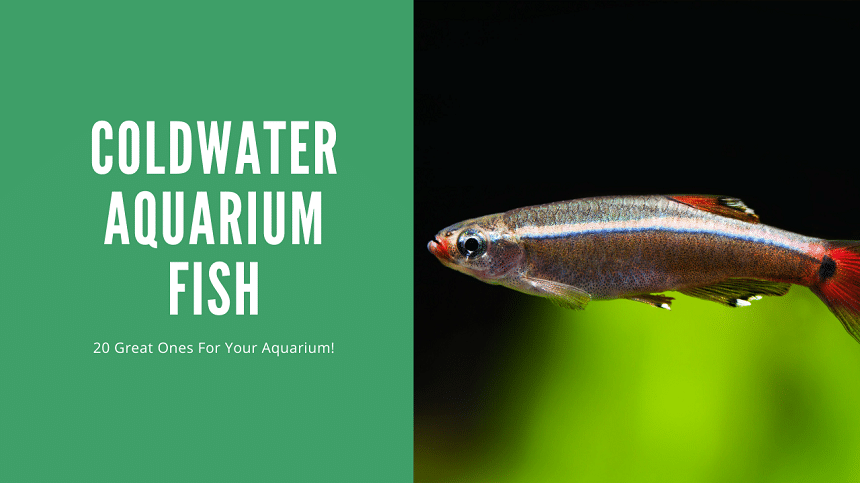
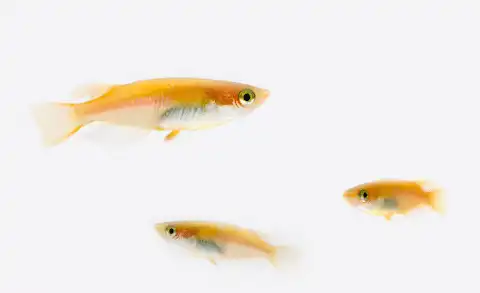
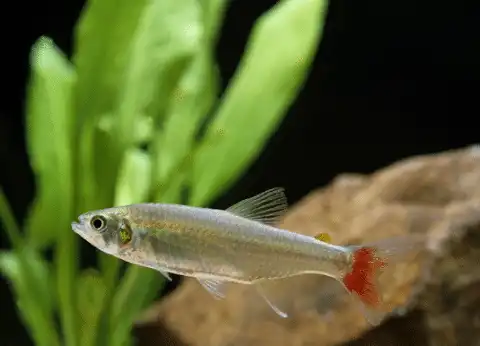

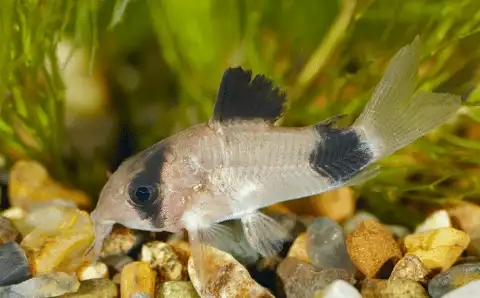
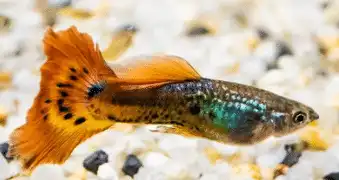
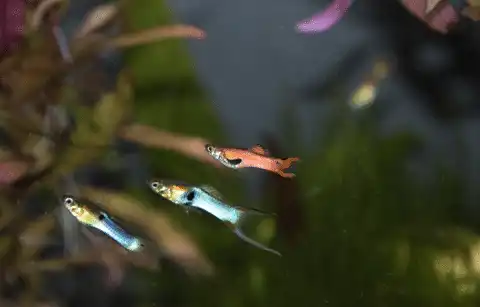

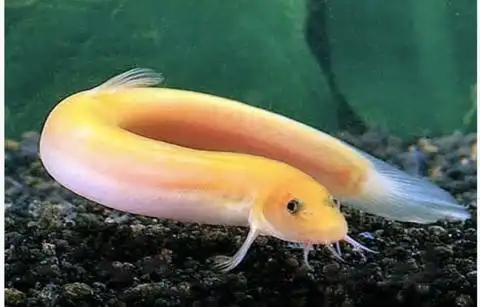
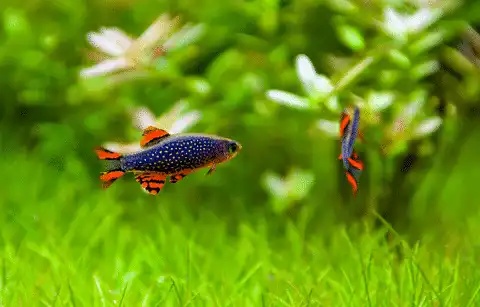
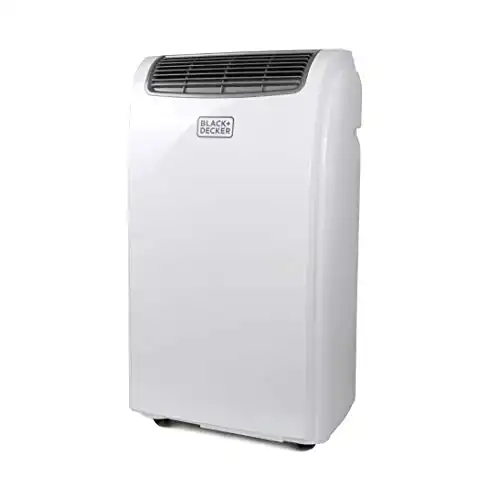




Every time I try to look go to “low-maintenance fish”, this opens up instead, both the links and even typing it in the URL.
Yes there. I would refer to our YouTube Channel. Unfortunately since Google’s helpful content update we had to prune our pages because Google was punishing our site for have low volume on several of our pages.